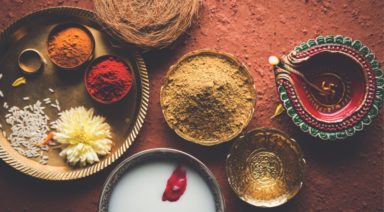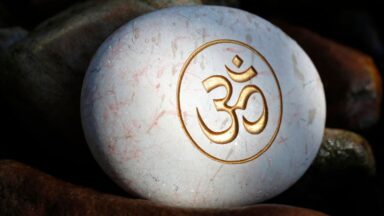Ayurveda: Preparing Your Kitchen as a Ritual Space for Healing

At the change of each season I take a few hours to clean out and prepare my kitchen for the next season. I sort through anything that doesn’t seem fresh or healthy and move it out. I then spend time creating fresh spice mixtures, soup stocks and other staples. This practice is calming and creates space in my life for eating well.
In Ayurveda, a form of wellness that stems from ancient India, but has direct application to contemporary life, we often say that the most important ingredient in food is the consciousness of the chef. Compare, then, the consciousness imbued in food lovingly prepared in the home with food cooked under pressure by a stranger in a commercial kitchen.
The choice is clear: home-prepared food has the potential for more consciousness-value and can, therefore, transmit more radiant health. Even more so when the chef clears the space and their mind prior to cooking. When the kitchen is lovingly prepared to create scrumptious and delightful food, high-value healthy food will be the result.
What can we do to make food a partner in the creation of our radiant health?
Preparing Your Kitchen
We can prepare our kitchen as a ritual space. Ayurvedic practitioner and educator Cate Stillman recommend performing a “kitchen sadhana” several times a year. In the seasonal kitchen ritual, we approach our kitchen as a temple. Just as we would not want to leave waste in a sacred space, we want our kitchen to be uplifting, free of debris, and be a space of clear, clean, energy. To create this creative space where we can transform loving thoughts into nourishment, we clear out any stale, left-over, or processed foods to make room for more lively, vibrant foods that are full of life-energy.
Spring is a perfect time to perform a ritual cleansing of your kitchen. To get started, approach your kitchen as a temple of your health. Find any foods that aren’t serving your highest good and clear them out. A well-stocked, clean kitchen, and clear mind while cooking results in vibrant health.
While we clear out stale, old, left-over, or processed foods from our kitchens, we can simultaneously begin to bring vibrant, life-filled foods into our kitchens. Visit a local farmer’s market for fresh, seasonal, often organic fruits and vegetables. Fill up bulk jars with grains, rice, and legumes. And because spices have very high potency and healing properties, fill a spice rack with freshly ground spices. Having a clean coffee grinder (one that hasn’t been used for coffee) in which you can grind spices and spice seeds into fresh powder makes it easy to have very fresh spices and spice mixtures at your fingertips.
Experience Your Food
In Ayurveda, the term “ama” is used to describe what we might call “sludge-factor;” really any obstruction to vibrant health and well-being. When food, experience, or emotion is undigested the body and mind produce ama. Every time we eat on the go, eat with improper food combinations, or when digestion is weak our bodies produce Ama.
Since, according to Ayurveda, ama is the root cause of many diseases, it is imperative to reduce ama. Signs that ama is accumulating in the body include brain-fog, excess weight, and a thick white coating on the tongue. Whenever we experience these signs they are indications that we should take measures to reduce ama.
Ayurveda gives us many ways to reduce ama, and many of these are found right in our kitchens. The first way to reduce ama is to strengthen digestion. To do this we can use digestive-fire (agni) enhancing spices in our foods such as fennel, cumin, coriander, turmeric, pepper, ginger, and salt. If digestion is weak we may experience gas, pain, or bloating after eating. One traditional way to strengthen digestion is to eat 1/2 tsp ghee (clarified butter) at the start of our meals or take a 1/2 cup of licorice tea about 15 minutes before a meal. Stewed apples is another wonderful recipe for reducing ama, stimulating digestion, and regulating elimination. Finally, we can use hot water routinely to reduce ama and stimulate digestion.
At the turn of the seasons, or when ama has accumulated in the body, it is recommended that we spend a few weeks taking a lighter or ama-reducing diet. An ama-reducing diet allows the body to naturally reduce waste, loose accumulated weight and strengthen the digestion. An ama-reducing diet is not indicated for long-term use but can be applied at the change of seasons or whenever you feel ama is accumulating.
Another way we can reduce ama is through smart food combining. While Ayurveda gives many rules for combining foods, the most important of these have to do with proper combinations for dairy. Because dairy is heavy, it becomes difficult to digest when eaten in combination with many other foods. In particular, Milk should not be combined with eggs.
While this may come to a surprise to many people on a western diet, Ayurveda describes how the combination of eggs and dairy creates an indigestible sludge throughout our digestive tract. The best way to avoid ama, in this case, is to avoid ama-creating food combinations. Traditional food combining can be a complex art, but here is a more simplified chart of food combinations to avoid, developed by Dr. Paul Dugliss, MD (link to food combination chart).
What’s On Your Grocery List?
Through simple methods of Ayurveda, we can also begin to shape our food choices for our particular constitution or our particular imbalances. Ayurveda acknowledges six primary tastes groups; sweet (dairies, meats, many grains), sour (yogurt, sauerkraut), salty (rock salt, seaweed), pungent (chilies), bitter (kale), and astringent (drying, like pomegranate). Each of these tastes transmits information to our bodies.
A well-balanced meal should contain some of each of these tastes, even if some are in a small proportion. The sweet taste, for example, is a tissue-building, nourishing taste. This is why many of us crave sweets (for better or for worse) when we are upset or need a boost of energy. Our body is asking us for more energy, more sustenance, and more nourishment. The salty taste builds a digestive fire and communicates warmth and heat to the physiology.
The sour taste is moisturizing. So someone who is weak, cold, and dry throughout their physiologies, could incorporate more of the sweet taste, salty, and sour tastes to bring in more vitality (ojas), more warmth, and more moisture. The bitter taste is purifying and cooling to the physiology. So someone who is experiencing hot flashes, rashes, or irritability could incorporate more bitter flavor into their diet to reduce their symptoms of heat in the body. In this way, Ayurveda can use taste as a mechanism to create change in the physiology.
For someone who is more balanced in their physiology, Ayurveda recommends eating along lines of the constitution, or predominant dosha. In Ayurveda, there are three dosas (literally, defects), that dominate our physiologies. Vata is thought to resemble air and ether. Pitta resembles Fire. Kapha resembles earth and water. People who are more Vata in their physiology tend towards a wiry body. They can be vivacious, anxious, and changeable. The tastes that are most balancing to Vata dosha are salty and sweet. People of a more Pitta nature are more Type-A.
They are driven, athletic, and can be intense. The most balancing tastes for those of a Pitta nature are Bitter and Sweet. People of a Kapha nature tend to be sweet, nurturing, and can tend towards being more heavy-set. The most balancing taste for Kapha people is Pungent and Astringent. Everyone needs all six tastes but the manner in which we use and proportion these tastes is different depending upon body type, and imbalance.
The key, however, to using the kitchen as a pharmacy starts with the practice of creating our kitchens as ritual spaces for healing and deep nourishment. When cooking is a ritual act, then healing will flow from this intention. When we allow consciousness into our kitchens we quite naturally and intuitively move towards the foods, tastes, and dishes that are most resonant with our physiologies.
When we are cooking we can ask ourselves the simple question: what taste is missing? How can I bring this taste into my food? When we are eating, rather than mindlessly shoving food into our mouths, we can pause and ask ourselves: what taste would I like to experience next? In this way, our kitchen becomes a temple, cooking a ritual act, and eating becomes a delight to the senses.
When cooking is a ritual act, then healing will flow from this intention.
Recipe & Ama reducing Dietary Duidelines
Stewed Apples Recipe (Dr. Paul Dugliss):
Ingredient (one serving):
• 1 whole, fresh, sweet apple, cored and peeled
• 2 whole cloves (per apple)
• 1/4 cup of purified water
Directions:
- Core, peel, and dice apple into small pieces.
- Add cloves, apples and water in a covered pot.
- Stew apples in 1/4 cup of water until soft consistency (usually takes about 5 to 10 minutes).
- Remove cloves and discard before serving.
- Let stand away from heat for 5 minutes, to cool a little
Hot Water Routine (by Dr. Raju)
The Hot Water Routine is not based on “flushing” out the toxins with large quantities of water. Instead, it is based on the effect of warm water on the tongue. This stimulates digestion. Through stimulating and enhancing digestion two things occur. First,
whatever food you take during the day is processed better, decreasing the likelihood that you will produce ama. Second, when the digestion is not working on a meal, stimulating it will cause it to “burn” up old ama. Thus, it is really the effect of warm, wet
water on the tongue that is responsible for most of the effect of the Hot Water Routine.
Instructions
1) Bring water completely to a boil and place it in a thermos (a one-quart thermos is ideal)
2) Take a sip on this every half hour throughout the day (more can be taken if you like)
3) Stop at 6 PM so that you do not have to be up in the night to urinate
4) If you are dealing with any digestive disturbances, place the following spices in a one-quart thermos with the water, letting them steep the whole day as you drink it: 1 tsp fennel seeds, ¼ tsp coriander seeds, and ¼ tsp cumin seeds
Ama reducing dietary guidelines (by Dr. Paul Dugliss)
General Considerations:
This diet is indicated in the case of low agni (low digestive power) combined with Kapha imbalance or Ama excess. Food should be fresh, well-cooked, tasty, satisfying.
Grains
- Barley-Light preparation such as soup, crackers, unleavened bread, etc.
- Rye: Crackers
- Oats: Cooked with water to a light porridge.
- Millet: Steamed or boiled.
Wheat Only preparations made from finely ground whole wheat flour:
- Crackers; light bread toasted; unleavened bread such as light, fresh and well-cooked chapati, Arabic bread, tortilla, etc.; couscous; semolina.
Rice
Basmati, white
Dahl and Beans
Yellow mung beans (green husk removed):
a) liquid dahl preparation
b) prepared with rice as a thin soup
Red lentils: same as preparation for mung beans.
Vegetables
Well-cooked, and slightly juicy in preparation: green leafy vegetables, white pumpkin, asparagus, artichoke, cabbage, zucchini, celery, carrot, spinach, tender eggplant (better with skin removed), tender white radish (prepared with some fat), and green papaya.
Dairy Products
Low-fat milk, goats milk, buttermilk, lassi, ghee (in very small amounts).
Oils
All in small amounts in cooking. Avoid coconut oil.
Sweeteners, Spices, and Condiments
Honey in small amounts. All spices, except salt. Pungent and sharp spices (pepper, ginger, etc.). Lemon juice.
Fruits
Ripe and in-season grapes, raisins (soaked, chewed well), pomegranate, papaya (small amounts), fig, apple, guava are especially good. Other fruits if ripe and in season. Avoid bananas and mango.
What Your Dosha Type Means for Your Diet

Ayurveda is Sanskrit for “the wisdom of life.” Ayurveda originated in India and pre-dates modern medicine by thousands of years.
Ayurveda healing differs from modern medicine in the following ways:
- Focuses on preventative techniques, instead of merely reacting to illness as it arises
- Diet and habits are more strongly considered when diagnosing and treating
- Emphasizes on the uniqueness of the individual and finding what works for you personally
Three Types of Ayurveda Doshas
There are three types of Ayurveda Doshas – kapha, pitta, and vata. Doshas are more commonly known as mind-body types and are derived from the five elements.
While we all have aspects of each of the three doshas, for most of us, there is one dosha that dominates. You can also be a combination of two doshas, but that is less frequent. Before you learn about the characteristics of each type of dosha, determine which one(s) are most pertinent to you by taking this quick quiz.
I took this quiz with a little bit of healthy skepticism, not expecting anyone dosha to be that much stronger than the others, but for me, the traits corresponding to vata dosha are twice as strong. There are several dosha quizzes online, all of which gave me similar results.
Once you determine which dosha pertains to you, read about the strengths and weaknesses of that dosha and what dietary changes you can make to keep yourself in better alignment. While this article focuses on dietary modifications, there are all sorts of supplements, lifestyle and yoga practices that are also beneficial.





































